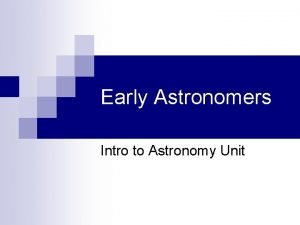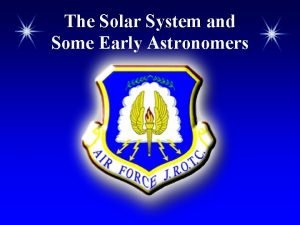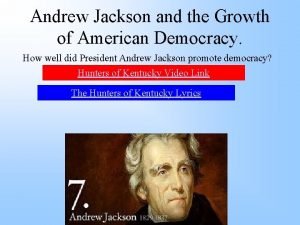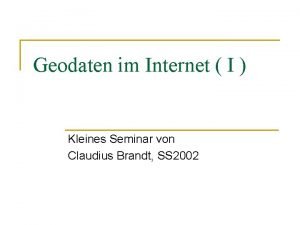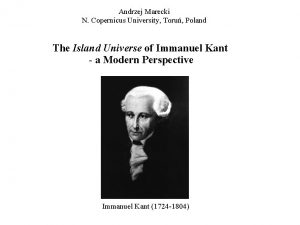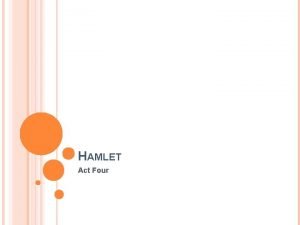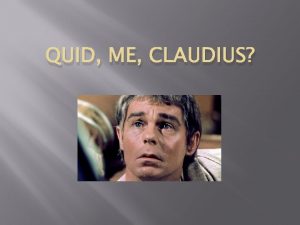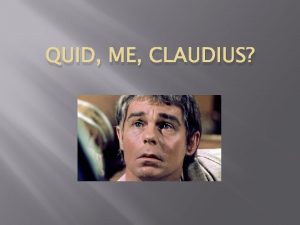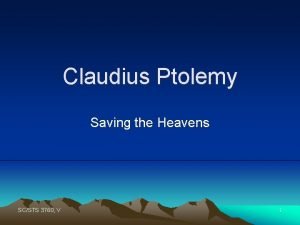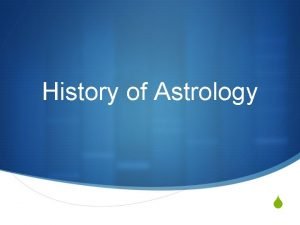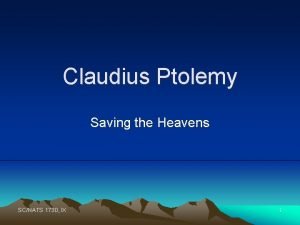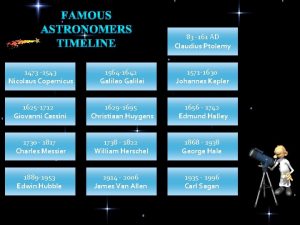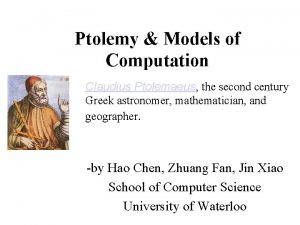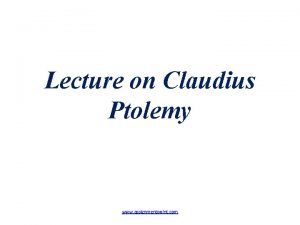Claudius Ptolemy c 90 168 Ptolemy promoted the










- Slides: 10

Claudius Ptolemy c. 90 -168 §Ptolemy promoted the (geocentric) idea that Earth was the center of the Universe and that all things revolved around it. §This theory prevailed for the next 1400 years. §The writings of Ptolemy include names and outlines of 48 constellations that are still in use today.

Nicolaus copernicus 1473 -1543 §Copernicus suggested that the sun was more likely to be in the center than Earth. §The idea of a heliocentric or sun-centered system is considered so important to history that it is often referred to as the "Copernican Revolution. "

tycho brahe 1546 -1601 §Tycho used a "quandrant" to precisely measure the positions of celestial objects, especially Mars. § He showed that comets must be farther away than the Moon. §Brahe was a colorful character. He got into an argument over a math question which led to a knife fight and part of his nose was cut off. He had a gold and silver replacement made and carried around a box of glue to keep it stuck on.

Galileo galilea 1564 -1642 §Galileo formulated the basic law that all objects fall at the same rate. §He constructed a refractor telescope with which he viewed craters on the moon, the phases of Venus, and the rings of Saturn. §He discovered four moons revolving around Jupiter. §He agreed with Copernicus that Earth and other planets revolved around the Sun. For promoting this and other science, he was arrested put on house arrest by the Roman Catholic Church.

Johannes kepler 1571 -1630 §Using Brahe's meticulous notes on the positions of Mars he was able to deduce that the planets orbit around the Sun, but in ellipses, not circles as Copernicus had assumed. §Kepler articulated three laws of planetary motion that are still in use today

Isaac newton 1642 -1727 §Listing all of Newton's contributions to science would fill volumes. §He designed a new type of reflecting telescope which is now called a "Newtonian" telescope. §He used a prism to show that white light is actually made of colors. §His laws of motion and gravity are the basis for understanding Kepler's laws of planetary orbits.

Edmund halley 1656 -1742 §Among his many studies are tides, magnetism, and trade winds. §He catalogued 341 southern hemisphere stars and discovered a star cluster in Centaurus. §He made the first complete observation of a transit of Mercury on November 7, 1677. §His most famous accomplishment is that he worked out a theory of the orbits of comets, concluding that the comet of 1682 (which still bears his name)

William herschel 1738 -1822 §He built a 48 -inch telescope which was the world's largest for more than 50 years. §He discovered what he first thought was a comet, but turned out to be planet Uranus. Eventually he also discovered two moons of Uranus; Titania and Oberon, and two moons of Saturn; Enceladus and Mimas.

Henrietta leavitt 1869 -1921 §She discovered that certain variable stars have a cycle that corresponds to their luminosity; the brighter the star, the longer the period. §This method became an important yardstick for measuring the size of the Milky Way as well as the distance to nearby galaxies.

Edwin hubble 1889 -1953 §He showed that there are giant systems of stars outside the Milky Way (which we now call galaxies) §Hubble's Law explains how the galaxies are receding away from each other. This movement suggests the Universe is getting bigger. If it is getting bigger, that means it use to be smaller. This discovery led astronomers to the Big Bang Theory.
 Claudius ptolemy astronomy contributions
Claudius ptolemy astronomy contributions Claudius ptolemy astronomy contributions
Claudius ptolemy astronomy contributions What territorial and economic changes promoted german unity
What territorial and economic changes promoted german unity Do you think jackson’s indian policy promoted democracy
Do you think jackson’s indian policy promoted democracy Gastric emptying regulation
Gastric emptying regulation Goal of promotion
Goal of promotion Claudius brandt
Claudius brandt Claudius ptolemaeus
Claudius ptolemaeus Claudius keizer
Claudius keizer Hamlet key scenes
Hamlet key scenes Julius claudius dinasztia
Julius claudius dinasztia
